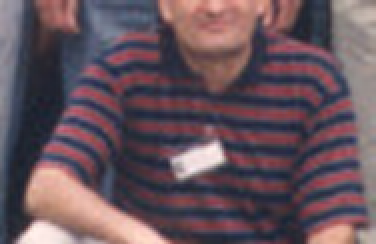Higher resolution or lower compression JPG's?
The question often arises as to whether to choose high resolution at high compression or low resolution at low compression, if both result in the same file size. As a test, I have chosen an image that has proven to be challenging for JPG so that we can see the limits of JPG compression. Below are two versions of the image at resolutions differing by a factor of two:

High resolution
Uncompressed
file size = 70,106 bytes

Low resolution
Uncompressed
file size = 17502 bytes
Following are JPG's of the same two images, with compression chosen to yield approximately the same file size for each:

High resolution
File size = 3,984 bytes

Low resolution
File size = 4,068 bytes
Now let's magnify these images to make the differences easier to see.

High resolution
Image magnified x 2

Low resolution
JPG file size = 4,068
Image magnified x 4
To my eye, the first image is clearly superior. Pixelation is much less noticeable, and the color degradation resulting from the JPG chroma subsampling is much, much less severe. The stripes are red, as they should be, rather than the purple we see on the right.
Some have suggested that a fairer comparison for viewing might be to do a bicubic resizing of the small image to match the dimensions of the larger image. Here is the result:

High resolution
JPG File size = 3,984 bytes

Low resolution
JPG file size = 4,068 bytes, then bicubic resized x 2.
and magnified x 2:

High resolution
JPG File size = 3,984
Image magnified x 2

Low resolution
JPG file size = 4,068, then bicubic resampled x 2.
Image magnified x 2.
The pixelation disappears if bicubic resizing is gone, but the image at right is clearly not nearly as detailed as the image at left. The red stripes are still purple, of course.
Is it just a chroma subsampling problem?
Most JPG compression implementations use chroma subsampling; that is, color information is stored at lower resolution than brightness information. This is a wise decision, as the human eye cannot resolve details of color as well as details of brightness. This chroma subsampling is the reason for the color shift in the red stripes above. In the smaller image, the stripe is so narrow that the whole stripe is wrongly reproduced.
The color degradation disappears when chroma subsampling is not used. Digital camera makers do not give us the option of turning off chroma subsampling, as do a few graphics programs. Should they? Let's investigate.
Martin Brown contributed comparison JPG images created without using chroma subsampling. He used "JPEG Optimizer" from xat.com to construct these images. (All digital cameras use chroma subsampline in their JPG compression.) Below is the set of comparisons constructed without chroma subsampling.

High resolution
File size = 3,984 bytes,
no chroma subsampling

Low resolution
File size = 4,068 bytes,
no chroma subsampling

High resolution
File size = 3,984 bytes
No chroma subsampling

Low resolution
File size = 4,068 bytes,
No chroma subsampling
Resized x 2 (bicubic)
Below are the above images magnified x 2.

High resolution
JPG File size = 3,984.
No chroma subsampling.
Image magnified x 2.

Low resolution.
JPG file size = 4,068.
No chroma subsampling.
Image resized x2 using bicubic resampling,
and then magnified x 2
JPG compression of the left image is beginning to produce the 8x8 blockiness that is seen in extreme JPG compression. The right images does not show these artifacts. However, the right image is blurry due to the bicubic resizing, and does not contain the detail that the left image does. I prefer the first image of each pair to the second, but may others prefer a blurry image to one with noticeable compression artifacts.
Of all the 4K renditions of the image, my favorite is the higher resolution image compressed with chroma subsampling. Here is a comparison of all this image to the above two:

High resolution
JPG File size = 3,984
No chroma subsampling
Image magnified x 2

High resolution
JPG File size = 3,984
Chroma subsampling
Image magnified x 2

Low resolution
JPG file size = 4,068
No chroma subsampling
Image resized x2 using bicubic resampling,
and then magnified x 2
I like the second image the best. It does not exhibit JPG artifacts of the first image, and it is much sharper than the third image. Except for the colors of the stripes, this image (including its color!) is very close to the original. The color accuracy of the stripes is far better than the low resolution image compressed with chroma subsampling.
Conclusions
Should you use high resolution and high compression or low resolution and low compression to store the best images? You have seen the data and you can draw your own conclusions.
Here are mine.
This test image is an unusual one chosen because it severely tests chroma subsampling. Most images will not suffer nearly as much from chroma subsampling as this one. (Note that some people wrongly characterize chroma subsampling as reducing color saturation. This is false.Chroma subsampling blurs color detail, which alters colors of narrow stripes that are only a couple of pixels wide.)
Higher resolution images retain much image detail even through the considerable compression needed to yield small file sizes. With chroma subsampling, the advantage of high resolution/high compression obvious, with more detail in brightness and color. The JPG artifacts degrade the image much less than choosing lower resolution.
When faced with a choice of two resolution/compression settings that yield the same file size, I will choose the higher resolution/higher compression setting for best image quality.
All images except those provided by Martin Brown were prepared using Paint Shop Pro. The two "original" images were both resized from a higher resolution starting image, and saved here as lossless PNG files. The magnified JPG's were created using a "pixel resize" and then stored as PNG files so as not to introduce any additional JPG loss.
Send comments to matthews@wfu.edu.